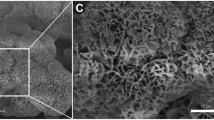Abstract
The effects of two kinds of bioactive glass and two kinds of phosphate-free glass on new bone development induced by dernineralized bone matrix (DBM) were studied in the rat abdominal muscle pouch model. After 8 weeks' implantation histomorphometric analysis revealed that the amount of new bone in DBM combined with bioactive glass was comparable to DBM without bioactive glass. DBM grafts combined with phosphate-free glass showed significantly less new bone formation. Scanning electron microscopic examination confirmed that new bone bonded to the surface of bioactive glass. The release of ions from the glass seemed to slow down after new bone had bonded to it. Exclusion of phosphate from a bioactive glass resulted in loss of ability to develop the Ca,P-rich surface layer needed for bone bonding. contains BMP and other growth factors capable of inducing bone formation when implanted in various sites in laboratory animals [17–19].
Bioactive glasses have several beneficial properties as a bone substitute. The crystal chemistry of the surface formed in in vivo apatite contributes to a high bone bonding rate [6, 8], and the rate of reactivity can be controlled by choice of glass composition [2]. In addition, bonding of glass to soft tissues has been reported [7, 20].
We have previously reported formation of new bone directly on bioactive glass, induced by DBM in rat muscle tissue [13]. In the present study, the effects of four different glasses on new bone formation in DBM were studied in an extraskeletal site.
Similar content being viewed by others
References
Andersson OH, Karlsson KH, Kangasniemi K (1990) Calcium phosphate formation at the surface of bioactive glass in vivo. J Noncryst Solids 119:290–296
Andersson OH, Liu G, Karlsson KH, Niemi L, Miettinen J, Juhanoja J (1990) In vivo behaviour of glasses in the SiO2-Na2O-CaO-P2O5-A12O3-B2O3-system. J Mater Sci Mater Med 1:219–227
Andersson OH, Liu G, Kangasniemi K, Juhanoja J (1992) Evaluation of the acceptance of glass in bone. J Mater Sci Mater Med 3:145–150
Donath K, Brenner G (1982) A method for the study of undecalcified bones and teeth with attached soft tissues. J Oral Pathol 11:318–326
Ducheyne P, Hench LL, Kagan A II, Martens M, Mulier JC (1979) Short term bonding behaviour of bioglass coatings on metal substrate. Arch Orthop Trauma Surg 94:155–160
Fujiu T, Ogino M (1984) Difference of bonding behaviour among surface active glasses and sintered apatite. J Biomed Mater Res 18:845–859
Happonen R-P, Vähätalo K, Yli-Urpo A, Andersson OH (1992) Short term surface reactions of a bioactive glass implanted subcutaneously in rat. In: Yamamuro T, Kokubo T, Nakamura T (eds) Bioceramics, vol. 5. Kobunshi Kankokai, Kyoto, pp 185–190
Hench LL (1988) Bioactive ceramics. Ann N Y Acad Sci 523:54–71
Hench LL, Andersson OH, LaTorre GP (1991) The kinetics of bioactive ceramics. In: Bonfield W, Hastings GW, Tanner KE (eds) Bioceramics, vol. 4. Butterworth-Heinemann, Guildford, p 155
Kotani S, Yamamuro T, Nakamura T, Kitsugi T, Fujita Y, Kawanabe K, Kokubo T (1992) Enhancement of bone bonding to bioactive ceramics by demineralized bone powder. Clin Orthop 278:226–234
Lindfors N (1992) Bioaktiva glas och mjukvävnadsstudier in vitro. MSc thesis, Abo Akademi University, pp 24–28
Lindholm TS, Urist MR (1980) A quantitative analysis of new bone formation by induction in compositive grafts of bone marrow and bone matrix. Clin Orthop 150:288–300
Pajamäki KJJ, Andersson OH, Lindholm TS, Karlsson KH, Yli-Urpo A (1993) Induction of new bone by allogeneic demineralized bone matrix combined to bioactive glass composite in the rat. Ann Chir Gyn 82 [Suppl 207]:137–144
Putte KA van de, Urist MR (1965) Osteogenesis in the interior of intramuscular implants of decalcified bone matrix. Clin Orthop 45:257–270
Reddi AH, Andersson WA (1976) Collagenous bone matrix-induced endochondral ossification and hematopoiesis. J Cell Biol 69:557–572
Reddi AH, Gay R, Gay S, Miller E (1977) Transitions in collagen types during matrix-induced cartilage, bone and bone marrow formation. Proc Natl Acad Sci USA 74:5589–5592
Takagi K, Urist M (1982) The reaction of the dura to bone morphogenetic protein (BMP) in repair of skull defects. Ann Surg 196:100–109
Urist MR (1965) Bone: formation by autoinduction. Science 150:893–899
Urist MR, Silverman BF, Buring K, Dubuc FL, Rosenberg JM (1967) The bone induction principle. Clin Orthop 53:223–283
Wilson J, Pigott GH, Shoen FJ, Hench LL (1981) Toxicology and biocompatibility of bioglasses. J Biomater Res 15:805–817
Author information
Authors and Affiliations
Rights and permissions
About this article
Cite this article
Pajamäki, K.J.J., Andersson, Ö.H., Lindholm, T.S. et al. Effect of glass bioactivity on new bone development induced by demineralized bone matrix in a rat extraskeletal site. Arch Orthop Trauma Surg 113, 210–214 (1994). https://doi.org/10.1007/BF00441834
Received:
Issue Date:
DOI: https://doi.org/10.1007/BF00441834




